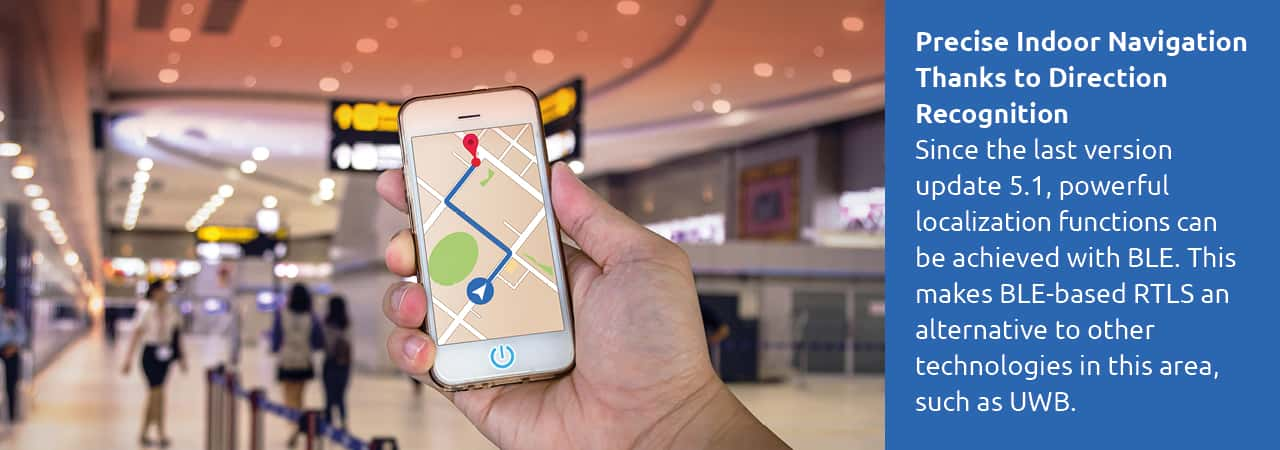An energy-saving, versatile, integral part of smartphones and devices in industry, commerce and healthcare.
How does BLE support the networking of objects and people?
More than 6 Billion Devices by 2024
In a study published together with ABI Research, the Bluetooth Special Interest Group (SIG) estimates that 6.2 billion Bluetooth-enabled devices will be supplied in 2024. This includes 1.14 billion connected devices for IoT applications and around 2.11 billion smartphones, tablets and PCs. 35 percent of these will be BLE-enabled devices.
By 2024, it is expected that all devices will be 100 percent dual-mode capable and thus support Bluetooth Classic and Bluetooth LE. The two technologies – Classic and LE – differ in the number and bandwidth of channels used, as well as the network topologies supported.
Compiled by RFID & Wireless IoT Global.
BLE Operates in the 2.4 GHz Frequency Range
From consumer electronics and proximity marketing to healthcare or industrial applications - these are the possible uses of Bluetooth Low Energy (BLE) and the demand for BLE solutions in the market is growing. Users take advantage of the power-saving communication technology, which is IoT-capable and has been a fixed component of all current smartphone models for years.
The technology can therefore be used and accessed on a large scale. BLE is the power-saving version of Bluetooth wireless technology. Developed for IoT, the technology enables applications via the Wireless Personal Area Network (WPAN) for short-range wireless technology.
The range of applications is broad and extends from networked fitness equipment to asset tracking solutions in industrial production. BLE-enabled devices transmit license-free at a maximum data rate of one megabit per second over an Industrial, Scientific and Medical (ISM) frequency band with 40 channels in the 2.402 to 2.483 gigahertz frequency range. The specifications, along with further and new developments of the wireless technology are driven by the Bluetooth Special Interest Group (SIG), to which the companies Apple, Microsoft and Intel belong.
The Current Status: Bluetooth 5
In early December 2016, the Bluetooth Special Interest Group (SIG) officially presented the fifth version of the Bluetooth standard. Version 5 increases the maximum data rate in Bluetooth applications to two megabits per second, the open-field range from 50 to around 200 meters and the transmission power from 10 milliwatts to 100 milliwatts. Doubling the data rate makes BLE faster, but a higher range also leads to lower data rates of 500 kilobits per second or only 125 kilobits per second, depending on the transmission mode selected.
Maximum Consumption of 10 Milliwatts
The net data rate of BLE is 0.27 megabits per second. Bluetooth-enabled devices can establish a connection within three milliseconds and complete a data transfer in six milliseconds without delay. The short signal pulses during data transmission contribute to the low power consumption of BLE devices with a maximum of ten milliwatts. Data protection is guaranteed by the 128-bit Advanced Encryption Standard (AES).
Modulation per GFSK and FHSS
Due to the modulation method applied, BLE is suitable for the transmission of small data packets in rapid succession. The modulation is accomplished using Gaussian Frequency Shift Keying (GFSK) and the Frequency-Hopping Spread Spectrum (FHSS). GFSK is a modulation technique using modified frequency shift keying (FSK), in which a Gaussian filter is used. Frequency shift keying filters the emitted carrier signal so that the high-frequency components of the signal are omitted and less bandwidth is required to transmit the signal. 1,600 frequency hops per second.
The FHSS ensures interference-free transmission and avoids collisions with other signal transmissions by transmitting with 1,600 frequency hops per second between previously defined frequency channels. For this purpose, the frequency band is divided into 40 channels with a bandwidth of two megahertz. Three of the 40 channels are reserved for communication between BLE devices.
At the lower and upper end of the frequency range, one frequency band each serves as a safety band to adjacent frequency ranges.
Blutooth 5.0: Faster or Wider?
Compared to the previous versions Bluetooth 4.0, 4.1 and 4.2, Bluetooth 5 can quadruple the range or double the speed, depending on the requirements. Furthermore, the maximum possible capacity for broadcasts was increased by 800 percent. Bluetooth 5 is fully downwards compatible with the previous versions up to 4.0. If a wireless module must also support the functions of older versions, a dual-mode implementation can be made, which supports both the Classic Mode (versions 1 to 3) and the LE Mode (versions 4 to 5). BLE in version 5.0 and above can thus either transmit data faster or communicate over a wider range.
IoT Feature Number 1: Direction Detection
With version 5.1, the Bluetooth specification has been expanded to include functions for directional detection and positioning acquisition. Depending on the design of a BLE application, this is intended to ensure centimeter-accurate object localization indoors. 'Bluetooth Direction Finding' is the main feature of the Bluetooth 5.1 core specification. This new feature supports localization services where previously only signal strength based technology with a Receiver Signal Strength Indicator (RSSI) was used.
BLE-based localization enables new and optimized possibilities for real-time location systems (RTLS) for object tracking in numerous applications, from logistics and warehousing to asset security in hospitals and production environments. Depending on the implementation, BLE positioning can be used for positioning in 2D or 3D. 'Bluetooth Direction Finding' is based on the two key concepts Angle of Arrival (AoA) and Angle of Departure (AoD).
The Angle of Arrival (AoA) and Angle of Departure (AoD) concepts make use of the angular phase shifts that occur between the antennas when receiving (AoA) or transmitting (AoD) RF signals. By using antenna arrays on both sides of the communication link, phase shift data can be determined and the location calculated.
IoT Feature Number 2: Mesh Networking Capability
Bluetooth mesh networks guarantee many-to-many (m:m) device communication and are optimized for creating large device networks. Designed to meet the scalability, reliability and security requirements of commercial and industrial environments, Bluetooth Mesh supports intelligent building and industrial implementations where tens, hundreds or thousands of devices need to communicate effectively. From factories to hospitals, airports, retail stores and homes, Bluetooth Mesh supports building technologies that provide added value to owners, operators and occupants.
With the release of the mesh specifications in July 2017, Bluetooth Mesh has played a key role in the development of emerging markets such as smart buildings, smart industry, smart cities and smart homes. More than 350 products with mesh networking capabilities have already been qualified by leading silicon, stack, component and end-product suppliers.
Indoor Localization
In the maintenance and logistics sector, BLE is best suitable for indoor localization, as GPS signals have a subdued reception quality within buildings and while NFC only functions properly over a range of a few centimeters. Technicians can locate and read out previously tagged objects such as keys or tools – BLE tags can be the size of a button cell battery – via their smartphones, for example, because BLE tags guarantee accurate localization within one meter.
Proximity Marketing
BLE beacons are also used for proximity marketing. In shopping malls or stores, for example, potential customers can receive location-based advertising via the BLE function of their smartphone or participate in the distribution of vouchers. For this reason, BLE proximity marketing is currently mainly used in retail, where BLE can also be used for internal process optimization via tracking & tracing or in consumer facing functions.
Building Automation
Building automation is the automatic, centralized control of the essential systems of a building, including heating, ventilation and air conditioning (HVAC), lighting and security. Bluetooth enables building automation solutions that leverage energy savings, reduce operating costs and improve the lifecycle of a building's core systems.
Source: RFID & Wireless IoT Global, Special Edition Wireless IoT Technology 2020






